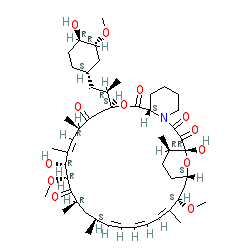GtoPdb is requesting financial support from commercial users. Please see our sustainability page for more information.
|
Synonyms: AY-22989 | Fyarro® (sirolimus albumin-bound particles) | Rapamune® | rapamycin | WY-090217
sirolimus is an approved drug (FDA (1999), EMA (2001))
Compound class:
Synthetic organic
Comment: Sirolimus is a macrolide produced by the bacteria Streptomyces hygroscopicus. It has potent immunosuppressive and antiproliferative properties. Sirolimus is classified as a Type IV allosteric kinase inhibitor [10].
Ligand Activity Visualisation ChartsThese are box plot that provide a unique visualisation, summarising all the activity data for a ligand taken from ChEMBL and GtoPdb across multiple targets and species. Click on a plot to see the median, interquartile range, low and high data points. A value of zero indicates that no data are available. A separate chart is created for each target, and where possible the algorithm tries to merge ChEMBL and GtoPdb targets by matching them on name and UniProt accession, for each available species. However, please note that inconsistency in naming of targets may lead to data for the same target being reported across multiple charts. ✖
View more information in the IUPHAR Pharmacology Education Project: sirolimus |
|
|||||||||||||||||||||||||||||||||||
| No information available. |
Summary of Clinical Use  |
| Sirolimus is used for prophylaxis of renal transplant rejection [7,12], and may be used in combination with cyclosporin A. In June 2015 the US FDA approved sirolimus for the treatment of lymphangioleiomyomatosis, a rare proliferative but benign lung disease [11]. Nab-sirolimus (ABI-009; Fyarro®) is an albumin-bound nanoparticle formulation of sirolimus that was developed by Aadi Bioscience as the first treatment for advanced malignant perivascular epithelioid cell neoplasms (PEComa; see NCT02494570) [9,14]. Fyarro® was approved by the FDA in November 2021. In May 2023 the EMA expanded authorisation to include the treatrment of angiofibroma of tuberous sclerosis. |
Mechanism Of Action and Pharmacodynamic Effects  |
| Sirolimus binds to the FK506 binding protein 12 (FKBP12), creating a complex which inhibits mammalian target of rapamycin (mTOR). The FKBP12-sirolimus complex binds to a site distinct from the kinase domain of mTOR and acts as a negative allosteric modulator of mTOR activity [2-3], interacting only when mTOR is bound to raptor and mLST8 [10]. This action reduces mTOR-induced proliferation of activated T-cells, the cells which would normally be involved in the immunological attack on transplanted tissue [7,13]. |
External links  |
|
For extended ADME data see the following: Electronic Medicines Compendium (eMC) Drugs.com European Medicines Agency (EMA) |








